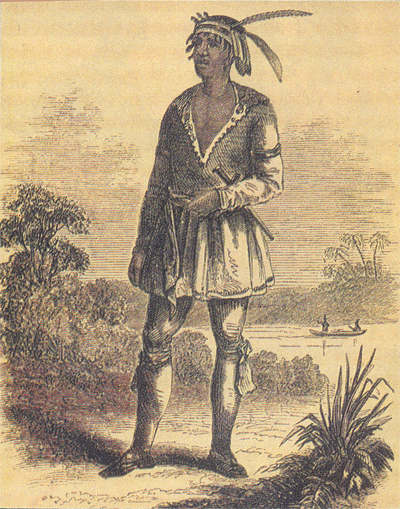
 |

 |
John Horse John Horse, also known as Juan Caballo, John Cowaya and Gopher John, was born in 1812 in Florida of a Black mother and an Indian father. He was described as six feet tall, muscular, and powerfully built. "Straight as an Indian," he walked with a self-assured air. Regarded as an expert marksman he could "follow a trail by moonlight at a gallop over a burnt prairie." He was cool under fire, courageous, brave and cunning. Striking in person, he dressed in Seminole Indian fashion. He wore a brilliant turban with plumes over his long straight hair, a hunting shirt gathered at the waist with a sash and silver clips on the lapels. His leggings were decorated with ribbons. There is an interesting legend as to how John Horse acquired the nickname, "Gopher John." One day, a U.S. Army camp commander bought some turtles from John and asked the youth to keep him supplied with fresh ones. Over the next few days, the commander paid for more turtles thinking that they were being added to the pen. At the end of the week when plans were being made for a banquet featuring turtle meat, the commander was stunned to find out from his cook that there were only two turtles in the pen. The officer realized that he had been tricked into repeatedly buying the same turtles. At first angry, then mollified by John's ingeniousness, he made the youth supply the turtles paid for and nicknamed him Gopher John to serve as a constant reminder of his prank. As leader of the Black Seminoles, John Horse struggled for almost half a century to obtain land and a permanent home for his people. He was a warrior against the United States during the Second Seminole War. To gain his freedom, he served the U.S. Army as a guide and interpreter. In the Indian Territory, he founded the village of Wewoka for his followers and made several trips to Washington, D.C., to lobby government officials on their behalf. John Horse, as second-in-command to the Seminole Indian Chief Coacoochee (Wild Cat), led more than one hundred Black Seminoles from Indian Territory to Mexico. From 1850 to 1870 he was head of the Black Seminole community in Nacimiento, Coahuila, Mexico, and took some of them back to Texas for service as scouts with the U.S. Army. The men were promised land after their service as scouts, but this promise never materialized. John Horse, old and recovering from wounds following an assassination attempt, returned to his home in Nacimiento. He died in Mexico City in 1882 while on a mission to settle a dispute over their land. Gopher John. Seminole Interpreter. Engraving reproduced from The Exiles of Florida by Joshua R. Giddings (Follet, Foster & Co., 1858). |